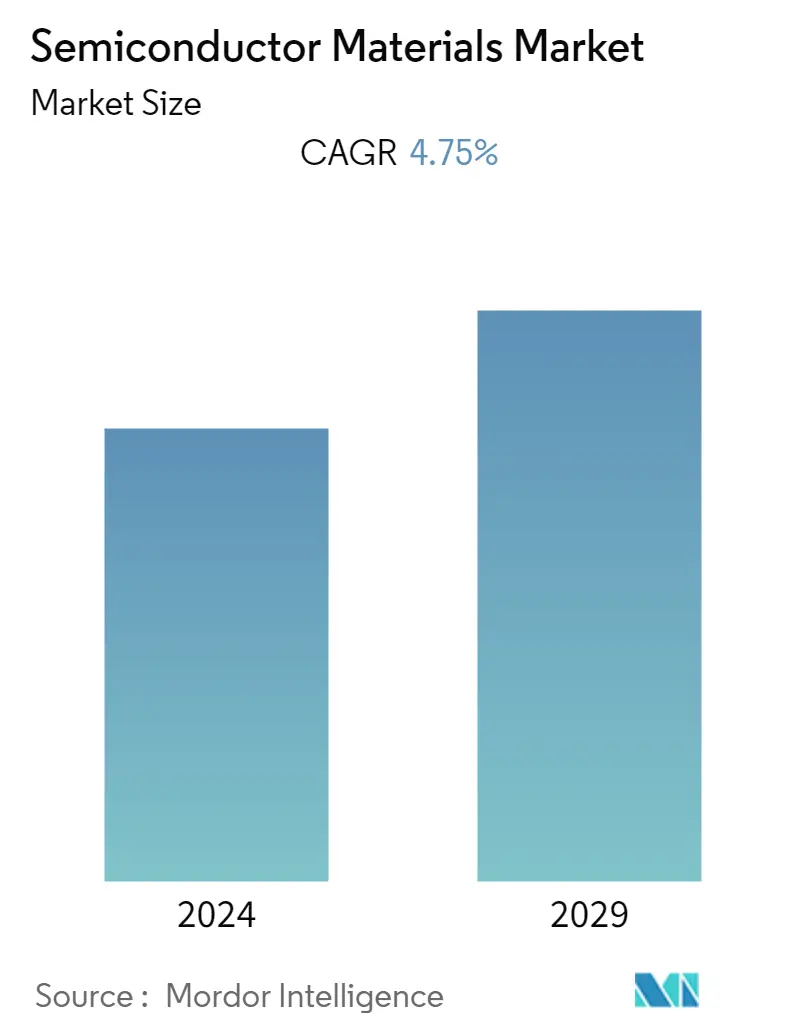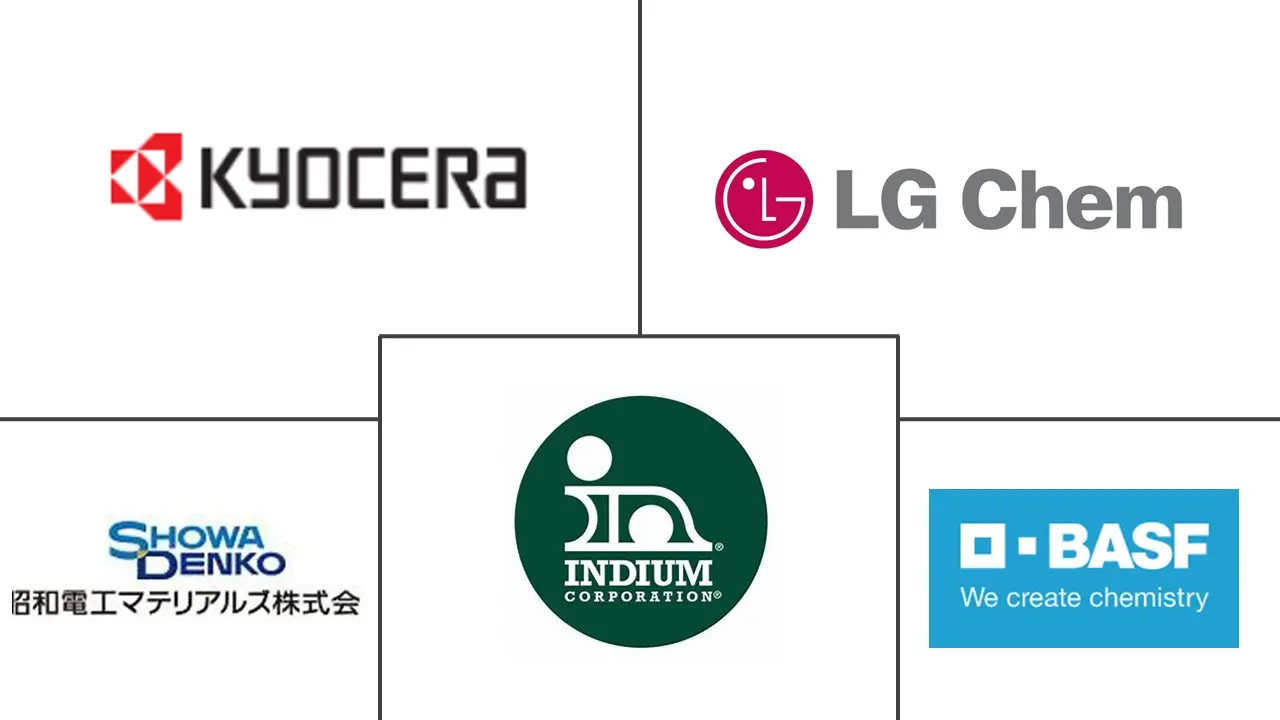Market Size of Semiconductor Materials Industry

| Study Period | 2019 - 2029 |
| Base Year For Estimation | 2023 |
| CAGR | 4.75 % |
| Fastest Growing Market | Asia Pacific |
| Largest Market | Asia Pacific |
| Market Concentration | Medium |
Major Players*Disclaimer: Major Players sorted in no particular order |
Semiconductor Materials Market Analysis
The semiconductor materials market size is estimated at USD 70.30 billion in the current year. It is expected to reach USD 88.66 billion by the next five years, registering a CAGR of 4.75% during the forecast period. Semiconductor materials represent one of the significant innovations in the electronics industry. By using materials such as silicon (Si), germanium (Ge), and gallium arsenide (GaAs), electronics manufacturers can replace traditional thermionic devices that make electronic devices heavy and expensive. Since the introduction of semiconductor devices, advanced miniaturization has progressed, and electronic devices have become more compact and mobile.
- With the miniaturization trend gaining momentum in the semiconductor industry, the demand for semiconductor materials is also expected to grow as manufacturing advanced node ICs, heterogeneous integration, and 3D memory architectures require more processing steps; this drives higher wafer fabrication and packaging materials consumption.
- Semiconductors are moving away from rigid substrates to more flexible plastic material and paper, all due to new material and fabrication discoveries. The trend toward more flexible substrates has led to numerous devices, from light-emitting diodes to solar cells and transistors.
- The semiconductor industry has been growing with miniaturization, and advancements and innovations in this field have directly impacted all downstream technologies. With the surging demand for high-end packaging solutions and rising packaging costs, OSAT vendors witnessed a considerable surge in demand from all the end-user industries, especially consumer electronics and automotive applications.
- The semiconductor industry is one of the most complex because of the more than 500 processing steps involved in manufacturing different products and the challenging environment faced by industry workers, including volatile electronics markets and unpredictable demand. It is considered. Depending on the complexity of the manufacturing process, there can be up to 1,400 process steps in semiconductor wafer manufacturing alone. Transistors are formed on the bottom layer, and the process is repeated as many circuits are assembled to create the final product.
- The Russia-Ukraine war is impacting the supply chain of semiconductors. Being a significant supplier of raw materials for producing semiconductors and electronic components, including various equipment. The dispute has disrupted the supply chain, causing shortages and price increases for these materials, impacting manufacturers and potentially leading to higher costs for end-users.
- Further, according to UkraineInvest, copper prices escalated to USD 10,845/mt in early March 2022. The ongoing war between Russia and Ukraine, high energy costs, and stricter emissions standards in Europe have been noted as the primary reasons for the continued shortage of copper.
Semiconductor Materials Industry Segmentation
Semiconductors are silicon-based materials that conduct electricity better than insulators like glass, but they are not pure conductors like copper or aluminum. Materials used to pattern the wafer are considered fabrication materials for the scope of the study. In contrast, the materials used to protect or connect the die are called packing materials. Semiconductor fabrication is a set of operations that involves depositing a sequence of layers onto a substrate, most often silicon, to create a device structure. Various thin film layers are deposited and removed in this process. Photolithography regulates the portions of the thin film that are to be deposited or withdrawn. Cleaning and inspection stages are usually performed after each deposition and removal operation.
The growth of global semiconductor materials market is segmented by application (fabrication (process chemicals, photomasks, electronic gases, photoresists ancillaries, sputtering targets, silicon, and other fabrication materials) and packaging (substrates, lead frames, ceramic packages, bonding wire, encapsulation resins (liquid), die attach materials and other packaging applications), by end-user industry (consumer electronics, telecommunication, manufacturing, automotive, energy and utility, and other end user industries), and by geography (Taiwan, South Korea, China, Japan, North America, Europe, and Rest of the World). The market sizes and forecasts are provided in terms of value (USD) for all the above segments.
| By Application | |||||||||
| |||||||||
|
| By End User Industry | |
| Consumer Electronics | |
| Telecommunication | |
| Manufacturing | |
| Automotive | |
| Energy and Utility | |
| Other End User Industries |
| By Geography | |
| North America | |
| Europe | |
| Asia Pacific | |
| Rest of the World |
Semiconductor Materials Market Size Summary
The semiconductor raw materials market is poised for significant growth, driven by the ongoing advancements in the electronics industry. The shift from traditional thermionic devices to semiconductor materials like silicon, germanium, and gallium arsenide has facilitated the miniaturization of electronic devices, making them more compact and mobile. This trend is further amplified by the increasing demand for advanced node integrated circuits, heterogeneous integration, and 3D memory architectures, which require more sophisticated processing steps and materials. The industry is also witnessing a transition from rigid substrates to flexible materials, such as plastic and paper, enabling the development of a wide range of devices, including light-emitting diodes, solar cells, and transistors. The complex nature of semiconductor manufacturing, with its numerous processing steps, coupled with external factors like geopolitical tensions and supply chain disruptions, continues to shape the market dynamics.
The consumer electronics sector, particularly smartphones, plays a pivotal role in driving the demand for semiconductor materials. The proliferation of IoT devices and the rollout of 5G technology are expected to further boost this demand, as these technologies require advanced semiconductor chips for enhanced connectivity. China's strategic initiatives, such as the "Made in China 2025" plan, are also contributing to the growth of the semiconductor industry by prioritizing research and development in this field. The automotive sector in China is expanding, with the government positioning it as a key industry, thereby increasing the demand for semiconductor chips in vehicles. The competitive landscape of the semiconductor materials market is characterized by the presence of major players like BASF, LG Chem Ltd., and KYOCERA Corporation, with ongoing innovations and expansions, such as Indium Corporation's new production facility in Malaysia and LG Chem's development of photoresist materials, further shaping the market's future.
Semiconductor Materials Market Size - Table of Contents
-
1. MARKET INSIGHTS
-
1.1 Market Overview
-
1.2 Industry Attractiveness - Porter's Five Forces Analysis
-
1.2.1 Bargaining Power of Suppliers
-
1.2.2 Bargaining Power of Consumers
-
1.2.3 Threat of New Entrants
-
1.2.4 Threat of Substitutes
-
1.2.5 Intensity of Competitive Rivalry
-
-
1.3 Assessment of the Impact of Key Macro Trends on the Market
-
-
2. MARKET SEGMENTATION
-
2.1 By Application
-
2.1.1 Fabrication
-
2.1.1.1 Process Chemicals
-
2.1.1.2 Photomasks
-
2.1.1.3 Electronic Gases
-
2.1.1.4 Photoresists Ancilliaries
-
2.1.1.5 Sputtering Targets
-
2.1.1.6 Silicon
-
2.1.1.7 Other Fabrication Materials
-
-
2.1.2 Packaging
-
2.1.2.1 Substrates
-
2.1.2.2 Lead-frames
-
2.1.2.3 Ceramic Packages
-
2.1.2.4 Bonding Wire
-
2.1.2.5 Encapsulation Resins (Liquid)
-
2.1.2.6 Die Attach Materials
-
2.1.2.7 Other Packaging Applications
-
-
-
2.2 By End User Industry
-
2.2.1 Consumer Electronics
-
2.2.2 Telecommunication
-
2.2.3 Manufacturing
-
2.2.4 Automotive
-
2.2.5 Energy and Utility
-
2.2.6 Other End User Industries
-
-
2.3 By Geography
-
2.3.1 North America
-
2.3.2 Europe
-
2.3.3 Asia Pacific
-
2.3.4 Rest of the World
-
-
Semiconductor Materials Market Size FAQs
What is the current Semiconductor Materials Market size?
The Semiconductor Materials Market is projected to register a CAGR of 4.75% during the forecast period (2024-2029)
Who are the key players in Semiconductor Materials Market?
BASF SE, LG Chem Ltd, Indium Corporation, Showa Denko Materials Co. Ltd (showa Denko K.K) and KYOCERA Corporation are the major companies operating in the Semiconductor Materials Market.


